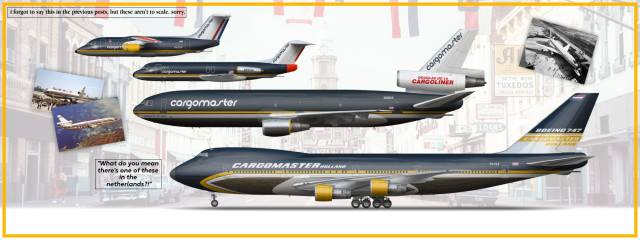
The Resonance Decade, the 1970's and 80's for CargoMaster
- Owner: Marx (View all images and albums)
- Uploaded: Jan 08 2024 05:38 PM
- Views: 362
- Album Cargomaster
MED/Airplano21

Compared to it's previous decades, the start of the 1970's was surprisingly tame for CargoMaster; the Boeing 747 and most importantly the Douglas DC-10 were unveiled to the public, and the Texas-based cargo airline would take no time to acquire both planes. On September 21st, 1970, CargoMaster would unveil the 747-100H to the public, and the year after on October 10th, 1971, the DC-10-10H was unveiled and put into service shortly after. Maybe the relationship between Douglas and CargoMaster wasn't dead, after all.
While the 747 was put on long range, intercontinental routes to supply focus cities on continents like Europe as a formidable and tanky airplane, the DC-10 was put to use as as a reliable source of resources for many smaller places that would otherwise need heavy and slow means of transportation to even be able to stay warm in the winter. The DC-10 became highly popular among CargoMaster employees, with the first DC-10 to arrive being nicknamed as the Guardian of Fort Worth. In 1974, CargoMaster had already taken delivery of 29 DC-10-10H and 7 DC-10-30H aircraft, with 4 additional DC-10-30HCF airframes. With 40 aircraft operating at once, the DC-10 was a highly popular airframe among just about everyone working at the Texan company. Around the same time, an adapted variant of the iconic late 1950's "Golden Stripe" paintjob was introduced with the company's first DC-10. Consequently, the 747 was the last CargoMaster plane to carry the original Golden Stripe livery.
The jumbo jet did not go to waste, however; as the DC-10 became known for it's risky approaches into deplorably dangerous airfields, the 747 became known for it's classy, elegant way of flight among CargoMaster's most experienced pilots. Although it had a ginormous size that was often prone to some reocurrent instability, pilots complimented the 747 massively; they cited the then-brand new jumbo jet as "a marvel of engineering that far exceeded anything CargoMaster had ever operated". The 747 was still considered hard to tackle and control once it got out of hand mid-air, but once pilots were able to memorize it's patterns, the queen of the skies became just like every other CargoMaster plane up until then; safe, reliable, and overall a masterclass of engineering. In 1974, CargoMaster had taken delivery of 18 747-100's, 7 747-200B's and 6 747-200M's, with 31 models flying as the year ended.
-
CargoMaster Holland obviously wasn't abandoned; the company's strategic location in the Netherlands became a focus point for the transportation of documents related to the North Atlantic Treaty Organization (NATO). The Fokker F-28 Mk 4000 was CargoMaster Holland's main show-plane for these types of flights; however, the Soviet Union began to keep track of those flights, which eventually resulted in thousands of interceptions, most of them being carried out by the Mikoyan-Gurevich MiG-21. These sudden interceptions eventually forced NATO to provide escorts for CargoMaster aircraft carrying sensitive information and documents on their payload, which eventually resulted in the 1977 Baltic Sea Stand-Off. On Christmas Eve in 1977, A CargoMaster Holland Fokker F-28 Mk 4000 registered as PH-CKO flying from Amsterdam to Stockholm Arlanda carrying sensitive NATO information from the Netherlands to Sweden was intercepted by two Soviet Mikoyan MiG-23 fighters. However, the Fokker F-28 was being escorted by two Northrop NF-5 fighters belonging to the Royal Netherlands Air Force. Both countries were intercepting the F-28 for approximately an hour, with thousands of calls from both countries calling for the cancellation of the interception. As the aircraft entered Swedish Airspace, the two MiG-23's split away, and the two NF-5's followed suit. The F-28 would soon land in Stockholm without any other issues.
Up until then, CargoMaster's regional planes did not have any cannons strapped to the back of their fuselages; early versions of the Mauser BK-27 27mm cannon would soon be installed after the 1977 incident. In 1984, CargoMaster Holland welcomed the BAe 146-200 to their continental fleet, which would fly side by side with the Fokker 28 on the company's aircraft line-up.
-
In the same year the BAe 146 was welcomed, the Boeing 737 Classic series made it's way into the company's line-up in the form of the 737-300H.
In 1985, CargoMaster made the largest bet of it's entire service life by purchasing the Boeing 767 and Boeing 757. On November 15th of the same year, the company received it's first Boeing 757-200H, and just a month later it would receive the Boeing 767-200H. As a standard, the -H variant had the usual M61A1 Vulcan autocannon strapped to it's tail. Due to the size of the M61A1, CargoMaster requested that it's 757's and 767's have a different mechanism controlling the horizontal stabilizers; the mechanism that controlled the rudder was left largely intact, but CargoMaster had to train it's own technicians and the technicians of other maintenance hangars on the different maintenance procedures of the Boeing 767H and the 757H. However, this training process wasn't always carried out, and this fatal failure often caused the wires connecting the stabilizers to the yoke to display erratic inputs. Although CargoMaster's management tried their best to raise awareness on the aforementioned procedures, one Boeing 757-200H, N13391, was not properly maintained; after 4 years of continuous service, it's horizontal stabilizers failed on September 29th, 1989, as CargoMaster Flight 270. The eventually contained the failure and made an emergency landing on Volkel Air Base.
After the 1989 close call, CargoMaster restricted the maintenance of it's 757 and 767 aircraft to it's own maintenance facilities, which halted any other failure on the horizontal stabilizers that was yet to occur. The crew of Flight 270 was awarded the Gold Medal Award for heroism by the Air Line Pilots Association. The crew's repeated attempts to divert away from populated areas and even the special request to land on an Air Force Base rather than an active airport were praised; the 757 was forced into a nose dive two times; a landing on a dutch cornfield was almost considered by the crew, however the decision to land in a military base was soon chosen, in which ATC directed the crippled 757 to Volkel Air Base. (More details coming soon in the following post, which will be published after this one).
Overall, the 1970's and 1980's were, as specified before, much more tame than the decades before for CargoMaster; Jerry Clifton, albeit considered old and "unable to keep up", was still very capable of handling some of his own company's problems and sometimes finances. Jerry atributted most of his will to work on his decades-old airline to the thought of making his compatriots in the 1920's and 30's, a considerable number of which had already passed away, proud of being able to see the Clifton Firm evolve into an intercontinental cargo airline service, even if posthumously. However, there was no proof that CargoMaster would be able to survive the following decades, and that certainly worried Clifton.
Until next time, brothers! ![]() -Marx
-Marx

 Sign In
Sign In Create Account
Create Account











